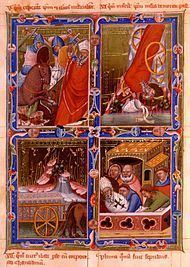Start date September 24, 1046 | End date 1046 | |
 | ||
The Vata pagan uprising was a Hungarian rebellion which in 1046 brought about the overthrow of King Peter Urseolo, the martyrdom of Bishop Gerard of Csanád and the reinstatement of the Árpád dynasty on the Hungarian throne.
Contents
Background
Christianity had been introduced in Hungary by the King Stephen I of Hungary. Upon his death in 1038, he was succeeded by his sororal nephew Peter Urseolo, a Venetian noble. Through tax increases, and Urseolo's involvement with foreign powers, he proved to be an unpopular ruler. The Hungarian peasants, still largely pagan, suspected he was intent on bringing Hungary into the fold of the Holy Roman Empire. In a rebellion in 1041, Stephen's brother-in-law Samuel Aba took control of the throne, overthrowing Urseolo. Urseolo fled to Bavaria, in exile allying himself with German king and Holy Roman Emperor Henry III.
In the years that followed, Aba's reign weakened, likely due to opposition from the church, who disliked his catering to pagan beliefs. With support from Henry, Peter Urseolo returned to Hungary in 1044, defeating Aba at the Battle of Ménfő. Urseolo regained the throne, but Hungary was no longer independent; it became a vassal kingdom of the Holy Roman Empire. However, his second reign would prove to be even more short-lived than his first.
Rebellion and Vata's mob
Andrew (András in Hungarian), Béla and Levente were the sons of Vazul, cousin of Saint Stephen. During the reign of Samuel Aba, they had fled the country in fear of their lives, Béla to Poland and András and Levente to Kiev. In 1046, András and Béla returned to Újvár (today: Abaújvár) in Hungary from their exile and quickly gained popular support for the throne, especially among the pagan populace, despite the fact that András was Christian (Levente had remained pagan). On their return, a rebellion began, which András and Levente initially supported.
During this rebellion, a pagan noble named Vata (or Vatha) gained power over a group of rebels who wished to abolish Christian rule and revert to paganism. According to legend Vata shaved his head in the pagan fashion, leaving three braids remaining, and declared war on the Christians. A slaughter of priests and Christians by Vata's mob ensued.
King Peter is said to have fled towards Székesfehérvár, where he was killed by the rebellious townspeople, and András, as the oldest brother, pronounced himself king. As András and Levente's men moved towards Pest, the bishops Gerard Besztrik (Hung. Beszteréd, Slovak Bystrík) Buldi (Hung. Bőd) and Beneta gathered to greet them.
In Pest, on September 24, the bishops were attacked by Vata's mob, who began stoning the bishops. Buldi was stoned to death. As the pagans threw rocks at him, Gellért repeatedly made the sign of the cross, which further infuriated the pagans. Gellért was taken up Kelenhegy hill, where he was put into a cart and pushed off a cliff, onto the banks of the Danube. Besztrik and Beneta managed to flee across the river, where Besztrik was injured by pagans before they could be rescued by András and Levente. Only Beneta survived.
Gellért was later canonized for his martyrdom and the hill from which he had been thrown was renamed Gellért Hill. Now in central Budapest, the hill has a monument on the cliff where Gellért, now a patron saint of Hungary, was killed.
Aftermath
The Vatha uprising marked the last major attempt at stopping Christian rule in Hungary. While Andrew had received assistance from pagans in his rise to the throne, he had no plans to abolish Christianity in the kingdom. Once in power he distanced himself from Vatha and the pagans. However, they were not punished for their actions.
